Campaign History of the 151e Régiment d'Infanterie - XVI
~ 1916 ~
Recovery from Verdun and Rebuilding (25 May - 18 September)
25-29 May: The regiment is at rest at its billets and spends the day cleaning uniforms, equipment and weapons. Losses for the regiment on 25 May include 1 missing. On 27 May, the regiment holds a prise d'armes and review at the Brillon maneuver grounds in order to award Lieut.-Colonel Moisson with the Croix de la Légion d'Honneur (see here), along with several Croix de Guerre to others. The regimental colors are taken by a company formed by the remaining elements of 3 Bat.


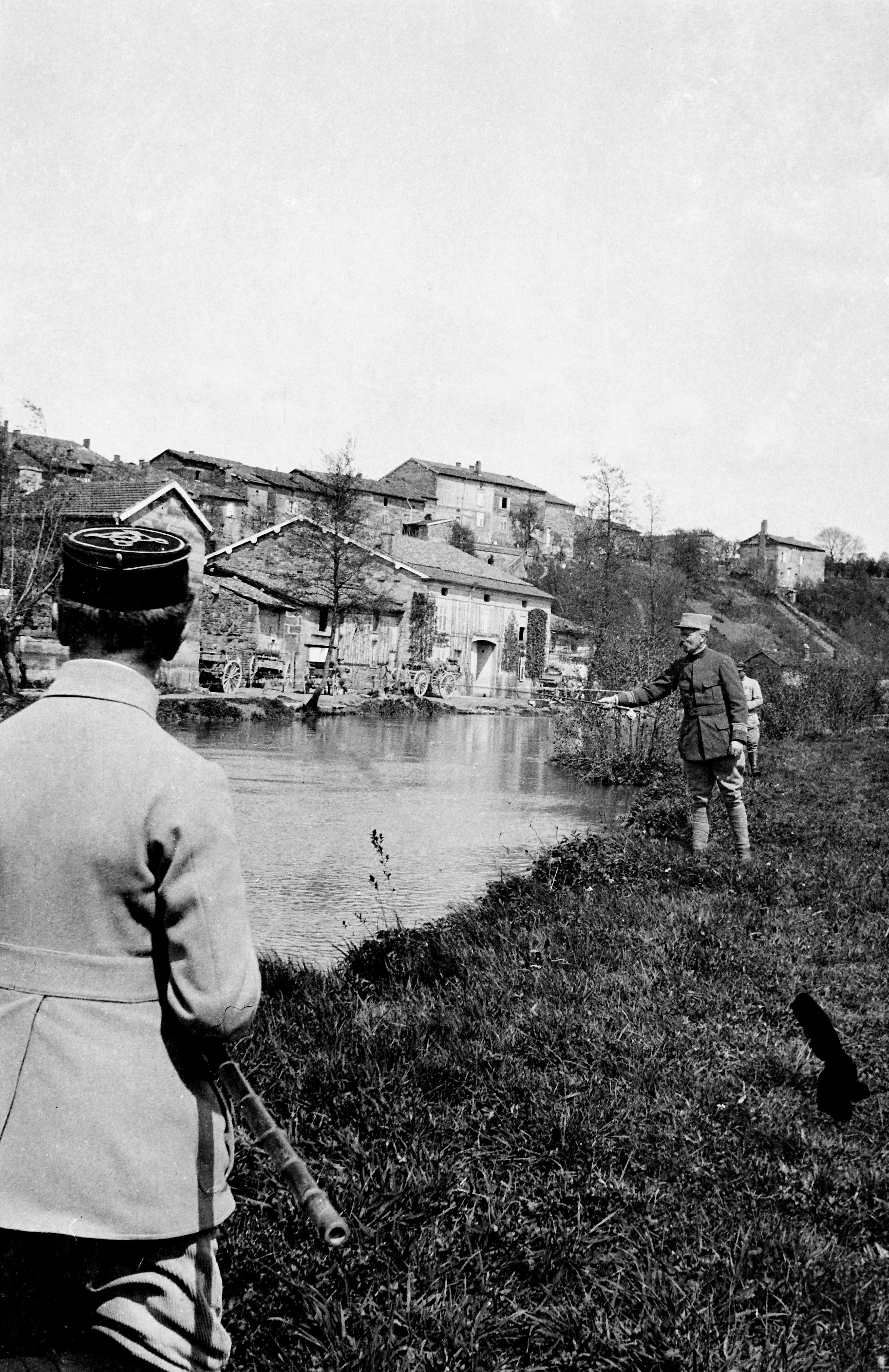
Officers of the 151 fishing at Longeville - 30 May 1916. (Photos taken by Capt. Tison, 151 RI.)
30 May - 7 June: The regiment departs its billets at Saudrupt and Brillon and marches to Longeville-en-Barrois by way of Bar-le-Duc. At Longeville it is transported by rail overnight to Barisey-la-Côte, 75 km to the southeast. From Barisey, the 3 Bat., CHR and regimental staff march off to Harmonville (Vosges), while 1 Bat. and 2 Bat. go to Punerot and Autreville, respectively. Upon arriving at Autreville, Bordinat (who had recently been transferred to 2 Co. under Capt. Bertrais) happily reported that they were very well received, the residents providing the men with fresh milk and eggs. On 3 June, the regiment undergoes a reorganization. Otherwise, the week is spent at rest.

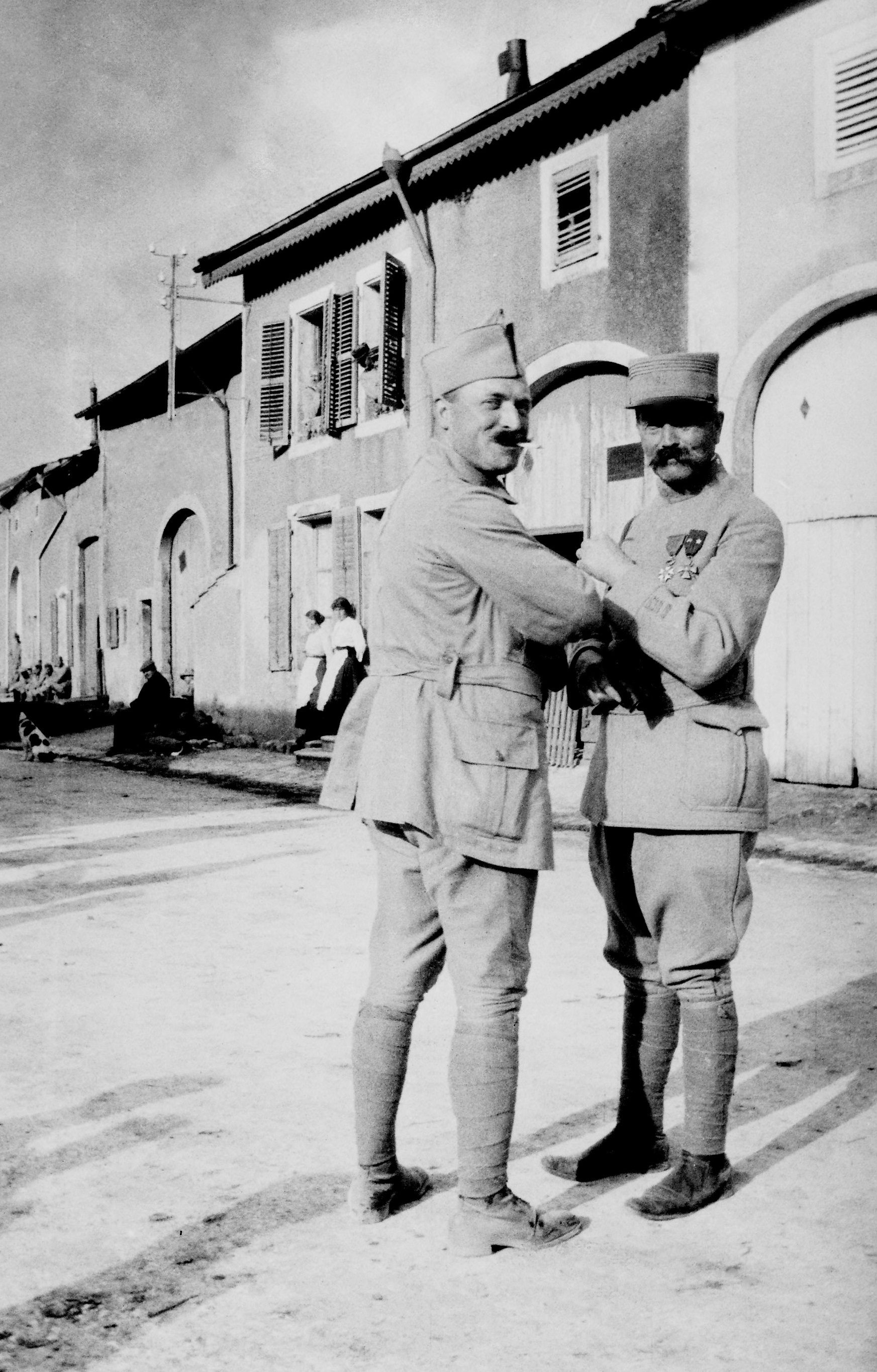

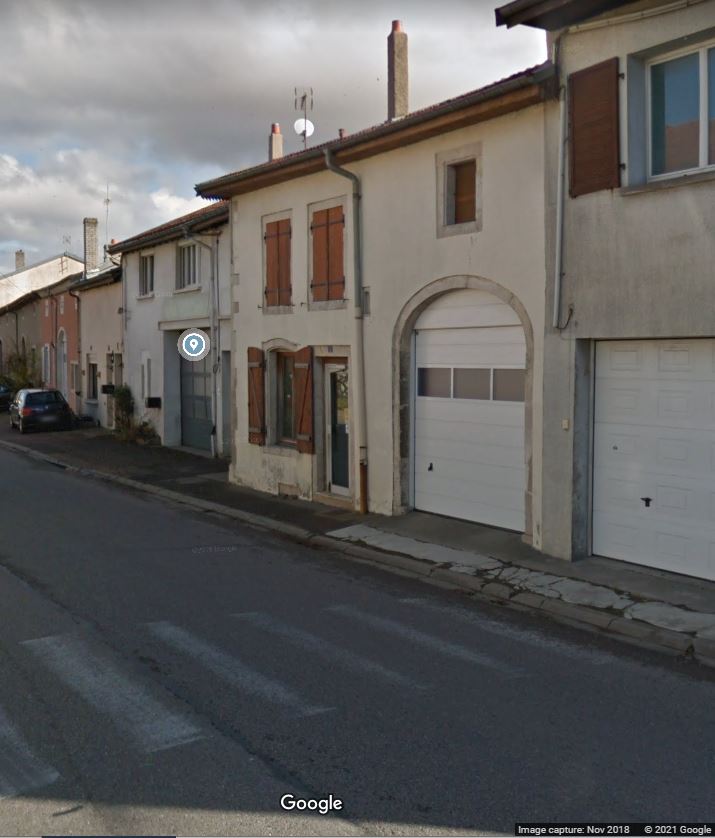
Autreville - 31 May 1916. Officers present: (Left) Giroult, Adam, Bertrois, Cormier, Dressayre, Choisic, and Antoine. (Center) Choisic and Oblet. (Right) Townswomen listening to the 151 regimental band. At Right: Google image of the same location in Blercourt today (location here).
8-10 June: With the regiment's period of rest over, it is time to return to the front. This time however, they will be sent to a quiet part of the line in Meurthe-et-Moselle. In the morning, the regiment boards trucks at Autreville and is driven to Marainviller (Meurthe-et-Moselle), a 75 km drive to the east. Bordinat already could recognize this as an ill omen:
We once again climb back into these damned trucks, which henceforward will presage only bad things to come for us sorry foot-soldiers. For if we're baptized as "heroes" from our time spent at Verdun, we should also be labeled as martyrs. In this long war, if there's anyone who's suffered more than the foot-soldier, I won't believe it.
Left: Map of the St. Clement sector encompassing Emberménil sub-sector from the JMO of the Health Service of the 42 DI. Center: Map of Emberménil sub-sector in April 1916 from the JMO of the 169 RI. Right: Map of the Emberménil sub-sector from June 1916 from the 151 RI JMO. Links to the maps available here, here and here.
Arriving in the evening, the 3 Bat. will be billeted at Marainviller while 2 Bat. goes to Laronxe, and the 1 Bat. CHR and regimental staff move off to Thiébauménil. The next day (9 June), the men are at rest while the regimental commanders conduct a reconnaissance of the new sector they are to occupy. At night, the 151 marches 8 km up to the front lines and relieves the 169 RI in the Emberménil -- LaNeuveville sub-sector. After the relief is complete, the regiment is arrayed as follows: 1 Bat. at the Emberménil Center of Resistance (CR), 2 Bat. at les Sapinières CR, and 3 Bat. in reserve at Côte 274.
The 151 is still severely understrength from the losses suffered at Mort Homme. Bordinat attested that companies had been reduced to only 30 or 40 men. When they arrived in the Emberménil sub-sector, those in the 169 RI asked where the rest of the 151's men were. The response was at once tragic and terrifying:
"Go to Verdun," we responded. There you can find them eternally sleeping. We learned subsequently that they too would get to know Verdun, which was a far cry from this peaceful area of Lorraine.Compared to where they had come from, their new sector seemed like a dream. Bordinat summed up the regiment's experience over the next several months succinctly:
Activity in our sector consisted solely of arming oneself with pick-axe and shovel, leaving our rifles to the side, except to go out on patrol from time to time...Apart from some small skirmishes and quibbling, each side trying to mess with the other. Our entire summer of 1916 was passed in this way.As an added comfort, when Bordinat's company would be in reserve near Laneuveville-aux-Bois, they enjoyed taking a drink from one of the nearby mineral springs.
11-30 June: For the first couple of days the sector remains calm aside from some occasional German 77 and 150 shells. On 11 June, 1 man (Sgt. Foreaux) is wounded. On 12 June, a detachment of reinforcements arrive consisting of 143 troops. They are composed of:
1 sergent, 2 caporaux, 50 men coming from the 21 RI depot
49 men coming coming from the 152 RI depot
1 sergent-fourrier, 1 sergent, 1 caporal, 37 men coming from the 109 RI depot
Late in the night of 13 June a fusillade opens up when an enemy patrol is spotted at les Sapinières CR. Otherwise the time is spent repairing the trenches and boyaux, which have caved in under the rain. The German artillery becomes a little more active, especially firing on the Emberménil station. On 14 June, Lieut. Bourgoin, previously evacuated, arrives from the 151 depot and takes command of 10 Co. With him is a detachment of reinforcements consisting of 65 troops. They are composed of: 3 sergents, 6 caporaux, 56 soldiers. During the day of 16 June, German airplanes surveille the French lines. On 16 June, 1 man (Sdt. Grall) is killed. The next day, the men are actively put to work repairing the trenches. The day after that, an internal rotation of units is conducted such that 3 Bat. moves up to Emberménil, 2 Bat. shifts to les Sapinières CR, and 1 Bat. moves back in reserve to Côte 274. On 18 June, 1 man (Sdt. Diot) is wounded. On 19 June, a mix of 77s, 88s, and 105s are fired at the point d'appui ("strong point") in the village, as well on the Bois des Bouleaux. Sous-Lieut. Mallet, previously evacuated, returns to the regiment and is assigned to 5 Co.
The following day sees an increase in German aircraft activity and that night, strong enemy patrols are sent out consisting of around 15 men. These are dispersed with rifle fire and grenades. On 21 June, two men are wounded (Sdts. Denis and Avorte). Seven sous-lieutenants arrive with the regiment:
Bloudeau coming from 18e Dragoons, assigned to 1 Co.
Kreiner coming from 3e Dragoons, assigned to 2 Co.
Bernet coming from 25e Dragoons, assigned to 6 Co.
de Montcalm coming from 7e Chasseurs, assigned to 7 Co.
de Blay coming from 1e Chasseurs, assigned to 9 Co.
Platte coming from 12e Hussars, assigned to 10 Co.
Collin coming from 4e Chasseurs, assigned to 10 Co.
On 22 June, German airplanes continue to be active in the skies, while on the ground, the men continue to work on improving the trenches. Sous-Liuets. Le Follec and Cartier coming from the 118 RI arrive along with a detachment of reinforcements consisting of 200 troops (2 adjudants, 1 sergent-fourrier, 5 sergents, 12 caporaux, 180 men). A second detachment also comes from the 60 RIT composed of 1 adjudant, 3 sergents, 9 caporaux. On 23 June, German artillery bombards the regiment's first line trenches, primarily around la Pointe. Three men are wounded (Cpl. Demarque; Sdts. Darras, Gaudichou). A detachment of reinforcements arrive coming from the 88 RI composed of 1 sergent, 2 caporaux, and 24 men. The next night, multiple German patrols are sent out to intercept the 151's wiring parties that are working to set up wire-entanglements. The patrols are all dispersed by the gunfire of the sentries. One man is wounded (Adj. Goëb). Commandant Gelly (brevetted) is promoted definitively to the rank, and Leiuts. de St. Croix and Jubien are promoted to capitaine. On the night of 25 June, the Germans open fire with some rifle grenades. One man is killed (Sdt. Lamois).
On 26 June there is a partial rotation of units such that 1 Bat. moves up to Emberménil CR, 3 Bat. goes to les Sapinières CR, and 2 Bat. moves back to the reserve at Côte 274. Sous-Lieut. Pégou coming from the 60 RIT arrives and is assigned to 3 Co. A detachment of reinforcements coming from 16 RI arrives composed of 1 sergent, 1 caporal-fourrier, 3 caporaux, and 15 men. There is some more shelling the next day, primarily on the 2 Jumeaux. Sous-Lieut. Hugon, previously evacuated, returns and is assigned to 1 MG Co. A detachment of reinforcements coming from the 98 RI arrives composed of 1 sergent-fourrier, 1 caporal, and 25 men. On 28 June, Sous-Lieut. Conduzorgues coming from the 139 RI arrives and is assigned to 2 Co. He accompanies a detachment of reinforcements from the 139 RI composed of 2 caporaux and 18 men. The following day the German artillery bombards the regiment's first-line trenches again. A detachment of reinforcements arrives from the 92 RI composed of 1 sergent and 8 men, along with 2 men from the 105 RI, and 2 caporaux and 6 men from the 121 RI, followed the day after by a detachment of reinforcements arrives from the 7 RI composed of 1 sergent, 2 caporaux and 15 men.

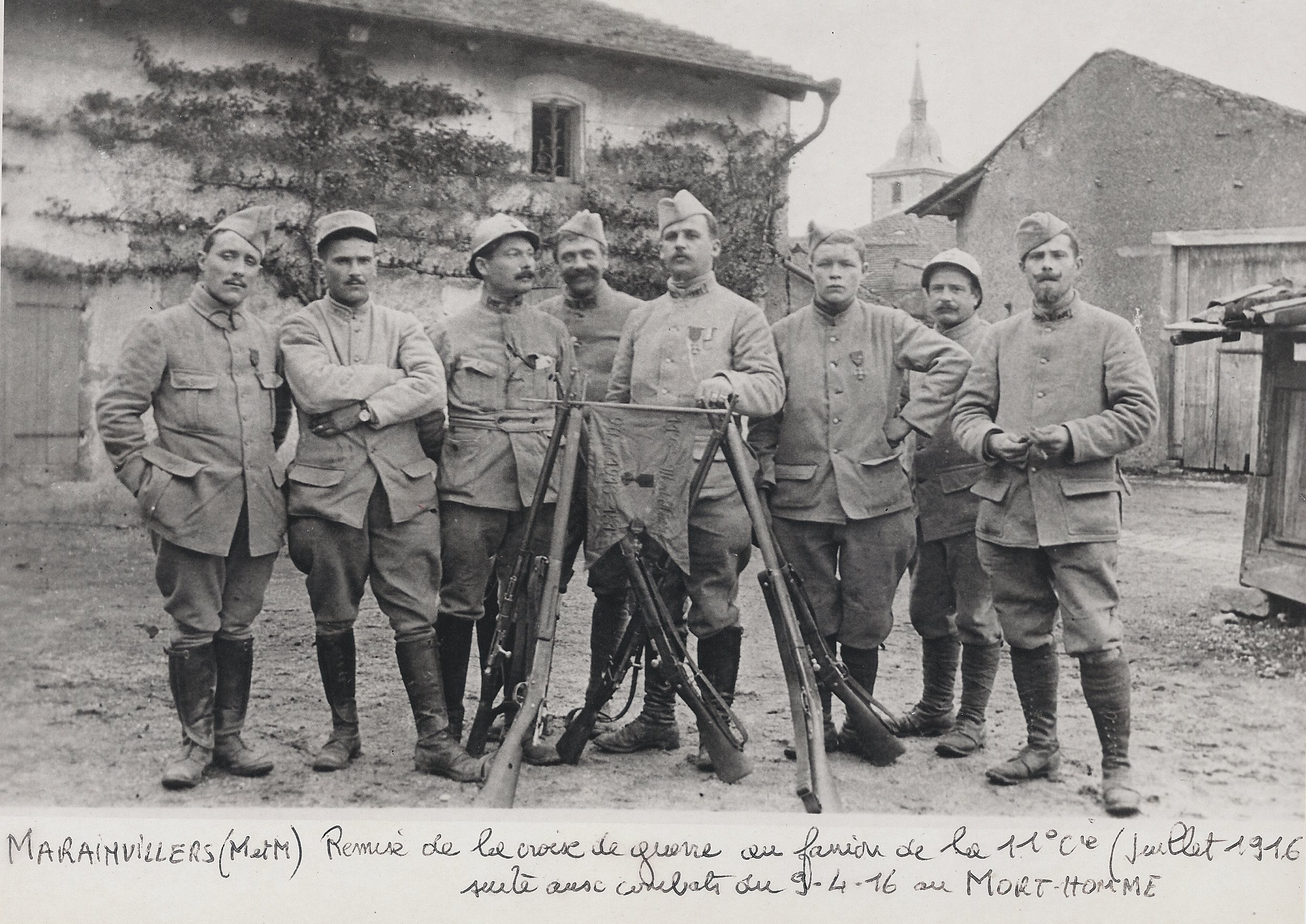
LEFT: The officers of the 3 Battalion at Marainviller. From left to right: Unknown sous-lieut., Lieut. Conduzorgues (11 Co.), Lieut. Guillot, Sous-Lieut. Dumesnil (9 Co.), Medecin Lieut. Minkowski, Lieut. Bourgoin (10 Co.), Lieut. Baillat (color-bearer), Sous-Lieut. Platte (10 Co.), Capt. Adj. Major Delavaivre, Sous-Lieut. Collin (10 Co.), Capt. Gelly (transferred from 2e Chasseurs), unknown lieut., Capt. Autier (9 Co.). RIGHT: Fanion of the 11 Co. decorated with the Croix de Guerre for its actions on 9 April 1916. (Photo taken by Capt. Tison at Marainviller - July 1916).
1-15 July: On 1 July, Mèdecin Aide-Major Dalidet coming from the Groupe des Brancardiers de Division is assigned to 2 Bat. and Mèdecin Aide-Major Rivière is transferred to the GBD. In addition, a detachment of reinforcements coming from the 147 RI arrives composed of 1 sergent, 2 caporaux, and 31 men. The next day the Germans fire thirty shells the regiment's first-line trenches. Around midnight, small enemy patrols approach the wire-entanglements but are dispersed with rifle shots. On the front of each company, patrols are sent out to surveilled the new enemy entrenchments. Chef de Musique Hardit and Capt. Ternisien, previously evacuated, return to the regiment. On July 3, patrols are sent back out on each company's front. Three men are wounded (Sdts. Jascques, Laval, Gage)
On 4 July, the fourth company (i.e. 4, 8, 12 Cos.) of each battalion is detached. This was presumably done in order to form a separate depot battalion. The larger context is that in the face of unsustainable losses, French command was reducing the regiment level formation. The end state is that the regiment would not consist of battalions of three-companies (from 12 down to 9 total). The seat of the sub-sector is modified. After the change, the placement of units is as follows: 1 Bat. at Emberménil CR, 2 Bat. at les Sapinières CR, 3 Bat. at rest at Marainviller. A detachment of reinforcements coming from the 91 RI arrives composed of 7 sergents, 1 caporal-fourrier, 2 caporaux, and 108 men. On 5 July, the enemy shells with 77s, 88s, and 105s the strong point at Poirier and Emberménil. Capts. Autier and Liéshaudt (brevetted) are definitively promoted to the rank, while Sous-Lieuts. Auriac, Adam and Coureaux are definitively promoted to lieutenant, as is Lieut. Doumat.
On 6 July, at 0200 hrs, a German patrol composed of a dozen men attempted to cut through the barbed-wire in front of la Pointe (les Sapinières CR) but fell back once fired upon by the sentries. All companies are employed in trench maintenance work and the tactical organization of the sector. Sous-Lieut. Salmon, previously evacuated, returns to the regiment and is assigned to 2 Co. Capt. Delavaine coming from the 111 RI takes command of 3 Bat. The next day, German artillery actively shells all of the regiment's first-line trenches and French artillery responds vigorously. During the night of 8 July, numerous enemy patrols work along the line of the regiment's advance wire-entanglements. One patrol is spotted slipping under the wire seven iron tubes containing Cheddite. The patrol is dispersed before it is able to set off the explosives.
On 10 July, around 2230 hrs, a powerful explosion is heard and felt, seemingly coming from a southern direction. A violent fusillade immediately erupts, sounds having been heard in front of the regiment's wire-entanglements between Tranchée de Sacs and T6. Advanced sentries had grendaes thrown at them and the firing extended along the entire front of the sub-sector. From the enemy's side, several machine-guns also opened up, while both sides artillery unleashed barrages. The firing would continue for two hours before dying down. Losses for the regiment on 10 July included 1 killed (Cpl. Pellem) and 5 wounded (Sdts. Klein, Blévec, Bassaget, Pichut, Sors).
Despite there being no reports of firing the next day the JMO records that 1 man was killed (Sdt. Maingny) and one was wounded (Sdt. Goassard). On 12 July, Sous-Lieut. Albertini, previously evacuated, returns to the regiment and is assigned to 6 Co. The next day is calm, however around 2200 hrs. a fusillade in the direction of Près Bois breaks out. At 0800 hrs, General Deville passes in review of 3 Bat. at rest at Marainviller and awards the Croix de la Chevalier de la Légion d'Honneur to Capt. Tison.

Capt. Gaston Joseph Tison in July or August 1916 (KIA 25 Sept. 1916)
The next day there are only a few exchanges of fire between opposing lookouts and a few 77 shells on Emberménil CR. An interior rotation takes place, after which the placement of units is as follows: 3 Bat. with 1 MG Co. at Emberménil CR, 2 Bat. with 3 MG Co. at les Sapinières CR, 1 Bat. with 2 MG Co. at rest at Marainviller. Sous-Lieut. Suisse coming from the Divisional Depot (DD) arrives to the regiment and is assigned to 2 MG Co. The 14 July, French independence day, was celebrated by Bordinat and his comrades in the village of Marainviller drinking "good Lorraine beer so well utilized in this region."
On the night of 15 July, a small operation is carried out with the objective of making a breach in the German wire-entanglements to the north of la Ferme du Mont-Laval. At 2130 hrs, the patrol (composed of volunteers) goes out and places five 4-meter long iron tubes filled with Cheddite under the German wire. The patrol then returns to their lines at 0200 hrs having accomplished its mission but were unable to ignite the fuse. Capt. Bazaille coming from the 9 Bat. of the 155 RI arrives to the regiment and takes command of 2 Co. One man is wounded (Sdt. Creff) on 15 July.
16-31 July: The day is calm aside from the arrival of a few heavy caliber shells coming from the direction of Bois de la Fourasse. On this day 1 man is killed (Cpl. Coiffier). On the night of 17 July, a patrol 200 meters from the Mousse Road discovers two crates of explosives hidden in the grass. The crates, which had been placed in order to blow up the regiment's wire-entanglements, are brought back to friendly lines. On 18 July, all units in line are employed in trench maintenance work and in the construction of small fortifications to allow for better flanking fire.
Around midnight on 19 July a light cannonade is heard on the right front, though nothing further is noted. Sous-Lieut. Hue, previously evacuated, returns to the regiment and is assigned to 3 Co. On 20 July, an interior rotation takes place at night, after which the placement of units is as follows: 1 Bat. at Emberménil CR, 3 Bat. at les Sapinières CR, 2 Bat.at rest at Marainviller. On the night of 21 July a patrol discovers iron tube of explosives 12 meters long in the advanced line of wire in front of Tranchée 12. The next day the enemy artillery becomes more active. Shots from a German 88mm coming from the direction of Mousse and Leintry fall around the Emberménil station. Sous-Lieut. Donsimoni Francois is transferred out of the regiment in order to oversee Moroccan troops.
On the night of 24 July an enemy patrol approaches the regiment's positions at Emberménil CR across from Tranchées 7 and 8 but is quickly dispersed using grenades. Sous-Lieut. Tramoy, previously evacuated, returns to the regiment and is assigned to 3 Co. On this day 1 man dies accidentally (Sdt. Hermabessière -- his death certificate states accidental drowning). At 2245 hrs on the night of 25 July, machine-guns open fire and there is a short fusillade and use of hand grenades on the right of the line. A German light projector placed in the direct of Corne Fritz searches the ground.
During the night of 27 July several German patrols appear in front of the regiment's wire-entanglements, opposite Tranchées 7 and 8 at Emberménil CR. These are all dispersed by French 75mm fire. Sous-Lieut. Basteau, previously evacuated, returns to the regiment and is assigned to 7 Co. Sous-Lieut Hucliez is definitively promoted to that rank. An interior rotation takes place, after which the placement of units is as follows: 1 Bat. at Emberménil CR, 2 Bat. at les Sapinières CR, 3 Bat.at rest at Croismare. On the night of 29 July, there is an encounter between two patrols opposite Ouvrage 22 and there is an exchange of grenades and rifle fire. A detachment of reinforcements consisting of 17 men arrives from the Division Depot (DD).
On the night of 30 July, an ambush is set by Sous-Lieut. Tramoy, a NCO, and three men with the objective of capturing a German patrol. Around 2200 hrs, a strong German patrol of about 20 men is surprised. Tramoy and his patrolers let the Germans come very close and then fire at point blank range. They take the body of German NCO back to their lines. On 31 July, the enemy's artillery bombards the regiment's first-line trenches and the PCs. French artillery responds in kind.
1-20 August: The first few days of August are uneventful. On 3 Aug. 1 man is killed (Sdt. Jamier). At 2300 hrs on 4 August, the Germans open up a brisk fire on the fatigue party near Tranchées 9 and 10 of the Emberménil CR after being spotted by a powerful light projector installed by the Germans near Remoncourt. The next night at 2130 hrs the German projector again illuminates the ground while German machine-gun fire opens up on another fatigue party. The same activity is repeated the night after that, when at 2215 the projector lights up the regiment's positions and machine-gun opens fire on the illuminated area. This time the French artillery responds and fires on the area of where the projector is located.
On 7 August, at 2030 hrs, the enemy opens up a strong fusilade on all trenches in the Emberménil CR. Elements of the 151 respond with a well regulated fire by salvoes, which causes the irregular fire of the enemy to cease immediately. The following night at the same time however, the Germans again open up a brisk fire on the regiment's trenches. Enemy patrols are also more active than usual. They make their way along the outside of the regiment's wire belt but are all dispersed once fired upon. On 8 Aug. a detachment of reinforcements composed of 17 men comes from the DD. The next few days pass without incident, excepting the usual exchange of fire between lookouts and sentries, and the occasional shelling by each sides artillery. On 11 Aug. 1 man is wounded (Sdt. Gautiez).
On 12 August, the machine-gun companies execute and internal rotation: 1 MG Co. relieves 3 MG Co. at Emberménil CR, while 3 MG Co. relieves 2 MG Co. at les Sapinières CR, the latter going back to rest at Croisemare. Chef de Bataillon Cmdt. Baudin arrives from the depot of the 91 RI and takes command of 3 Bat. The next night, the battalions execute their own internal rotation: 1 Bat. relieves 3 Bat. at Emberménil CR, while 3 Bat. shifts to the right and relieves 2 Bat. at les Sapinières CR, with the latter then heading back down to rest at Croisemare. A week passes with only the occasional exchange of sentry fire, some light shelling, and night patrols. In the line, the men are put to work fixing up the trenches. Platforms for rifle machine-guns (Chauchats) are created at T1 bis and T2 bis.
21-31 August: Rumors had already been circulating for days that the regiment would be sent to the Somme to fight. This news seemed to be confirmed when on 21 August, the regiment is alerted that it will be leaving the sector for good. Before departing this quiet sector in Lorraine, Bordinat remarked: ...My strongest memory from my time in this country is having been devoured by lice, my comrades suffering from the same. On the night of 21 August, the 1 Bat/151 RI is relieved at Emberménil CR by the 1 Bat/11 Cuirassiers (galvanized into infantry), the former then heading back down to Marainviller. The night after (22 Aug.) the 3 Bat/151 RI will be relieved by a battalion of the 10 RI, with the former going to billet at Marainviller. To make room, the 1 Bat. moves off to Blainville-sur-l'Eau. The entire regiment will be at rest the next day.
On 24 August, the entire regiment departs its billets. The 1 and 2 Bats., along with the CHR and regimental staff, will march to Morivillers (20 km to the southeast) to billet, while the 3 Bat. goes to Remenoville, and the machine-gun companies at various farms nearby. The next day will be spent at rest and cleaning uniforms and equipment before an instruction program resumes on 26 August. The morning is dedicated to exercises while the evening is spent in specialist training.
A brief distraction from the routine occurs on 27 August when the 151 participates in a ceremony marking the two year anniversary of the martyrdom of the town of Gerbéviller (Meurthe-et-Moselle). On 24 August 1914, a small band of French chasseurs heroically held back the advance of a massive German force for 24 hours. German forces (the 60 and 166 Infantry Regiments) believed that civilian francs-tireurs were the reason to blame, though this is likely not the case. In retaliation, the village was pillaged and burned, and the townspeople brutalized. At least 60 French civilians were massacred, including 15 French who were shot just outside of the town at place called la Prêle. Included among the victims were women, children and old people. Many more were captured and sent into forced labor. The only saving grace came from the efforts of Sister Julie and a parish priest, who managed to save an area of the village from the flames which had been packed with French wounded.
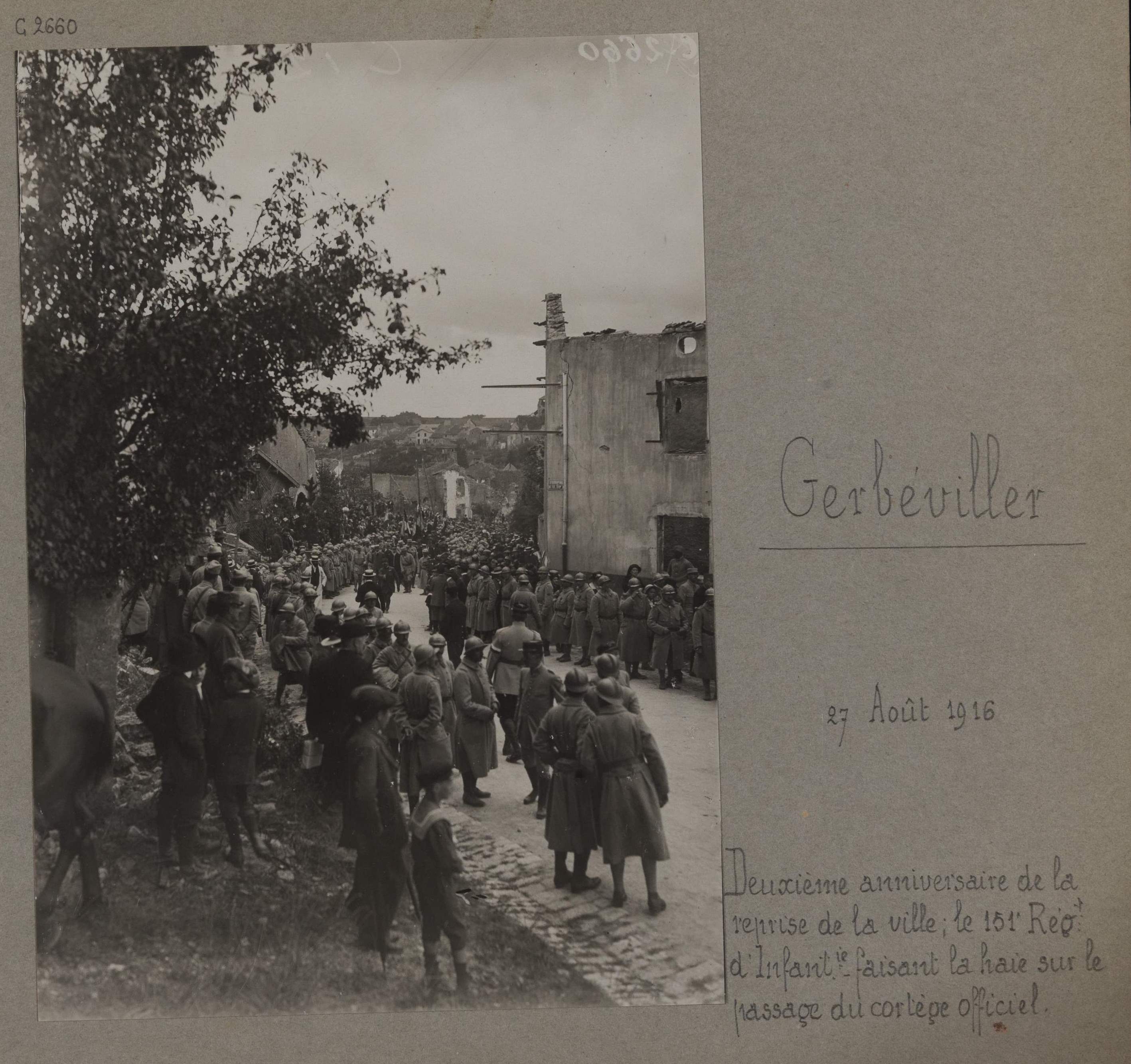

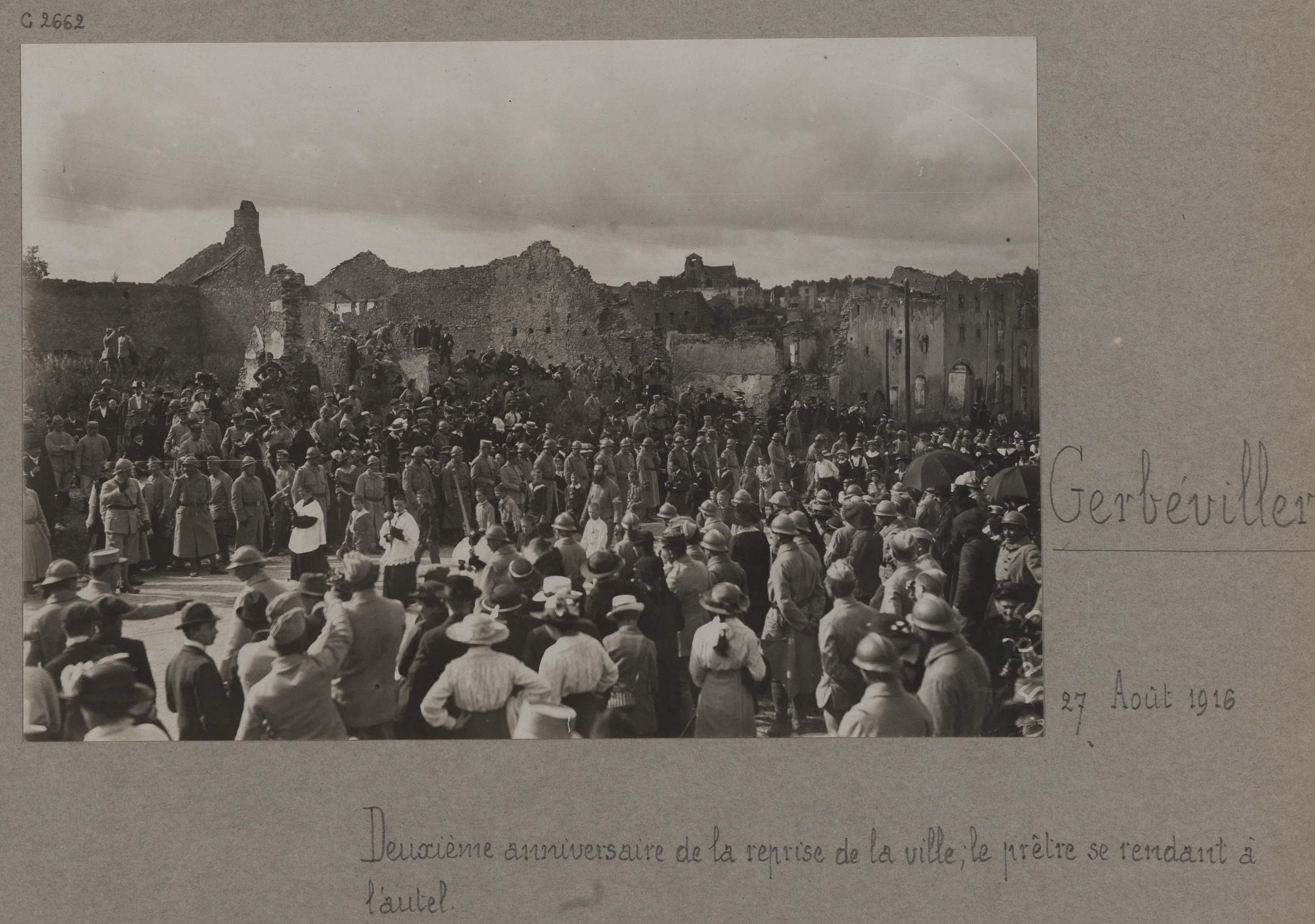
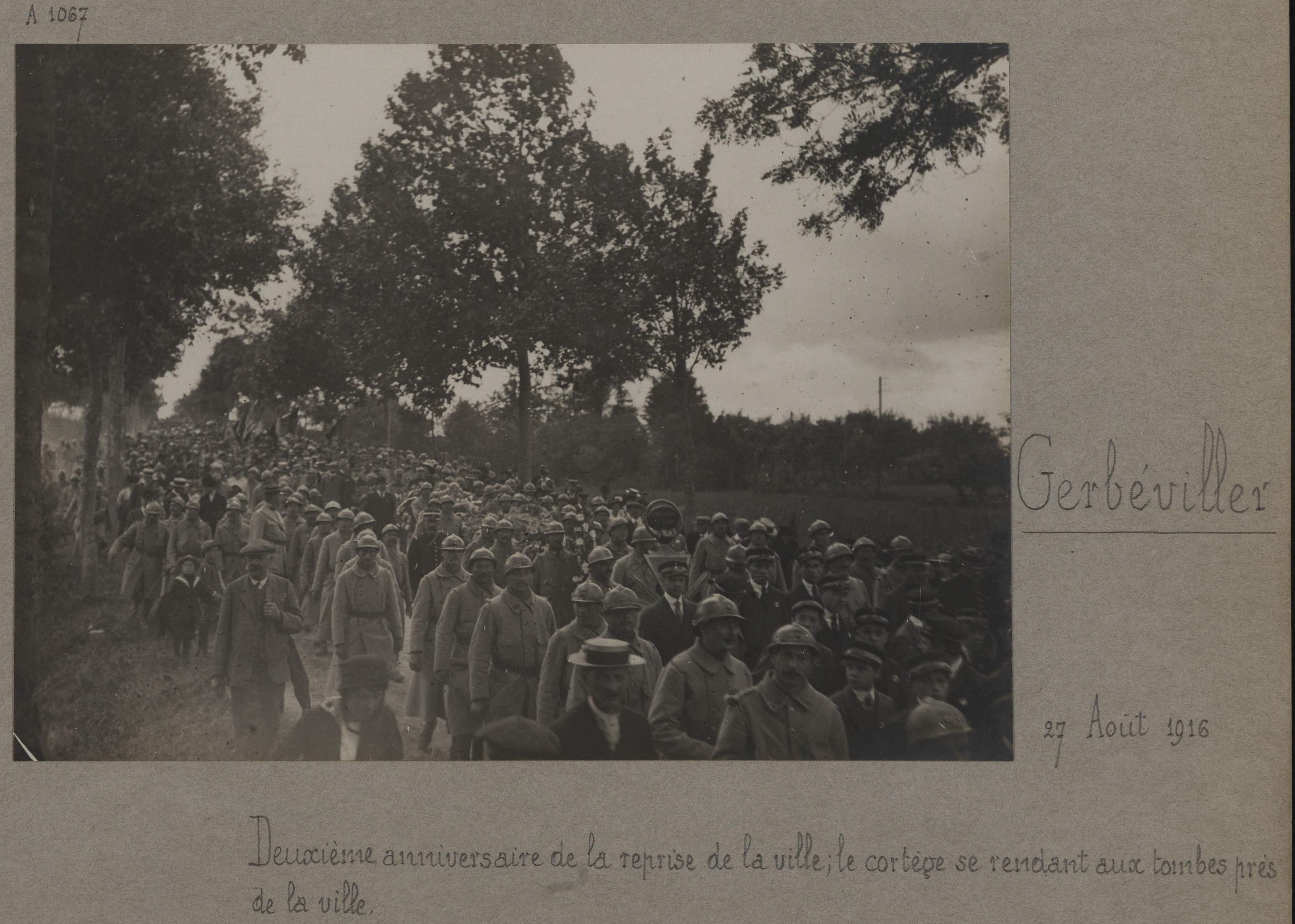

The 151 RI formed up as the honor guard along the route of the ceremonial procession at Gerbéviller on 29 August 1916. Photographs from the Valois Collection.
On 27 Aug. Sous-Liet. Adam, previously evacuated, returns to the regiment and is assigned to 2 Co. On 28 Aug. a detachment of reinforcements composed of 17 men comes from the DD. Following morning exercises on 30 August, the regiment carries out a prise d'armes between Remenoville and Moriviller, the regimental colors being taken by the CHR. Lieut.-Colonel Moisson decorates several men with the Croix de Guerre. The instruction program resumes on 31 August.
1-19 September: The advanced training would continue for several more days. Then on 4 September, the regiment sets off for Camp Saffais to practice combat exercises providing by a Battalion d'Instruction (BI). For the next the regiment will conduct combat drills such as assaulting an enemy trench system by battalions and then by an entire army corps. During this time, the 1 and 2 Bats. billet at Crévéchamps, while the CHR and 3 Bat. are assigned to Velle-sur-Moselle. On 8 Sept. a detachment of reinforcements composed of 35 men comes from the DD.
On 10 September the regiment leaves its billets in the sweltering heat and marches to Pont Saint-Vincent where it boards four trains. Though the rumors had not yet been confirmed in the ranks, most strongly suspected they were at last being sent back into battle. The 151 will spend that night, all the next day and the night following gradually being transported far to the west. The roach starts to creep back into the hearts of the men. There was a subtle yet pervading feeling of being cattle penned up and shuttled off to the slaughter.
The trains will first skirt around the suburbs of Paris (as all train lines connected back to the capital) before at last arriving at the destination at Grandvilliers (Oise) on 12 September. After detraining, the 2 and 3 Bats. will billet at Sommereux and the 1 Bat. with the CHR and regimental staff at Dargies. Even though they were still 80 km from the front, from here they could already hear the sound of the distant bombardment. The 151 will spend the next four days undergoing the same advanced training as before. Sous-Lieut. Krémer, previously evacuated, returns to the regiment and is assigned to the 2 Co.
The regiment will be given a day of rest before it boards trucks at 0900 hrs on 18 September in order to be transported to the Somme front. The ride takes all day, as they pass through Amiens and then Viller-Bretonneux, before arriving at their destination, Bray-sur-Somme, at 1900 hrs. The entire regiment will bivouac for the night on the sodden ground by the northwest entrance of Bray. The next day, because of the stormy weather, the regiment is driven in trucks the short distance to Camp Gressaire (just north of the neighboring hamlet of Chipilly) in a rare consolation to ensure that the men are well rested before going up to the front. It will pass the afternoon and evening at Camp Gressaire, presumably in better shelter than that afforded by their tents. It was the last chance to get a good night's sleep, for the next day the 151 would be sent up to the front line trenches.
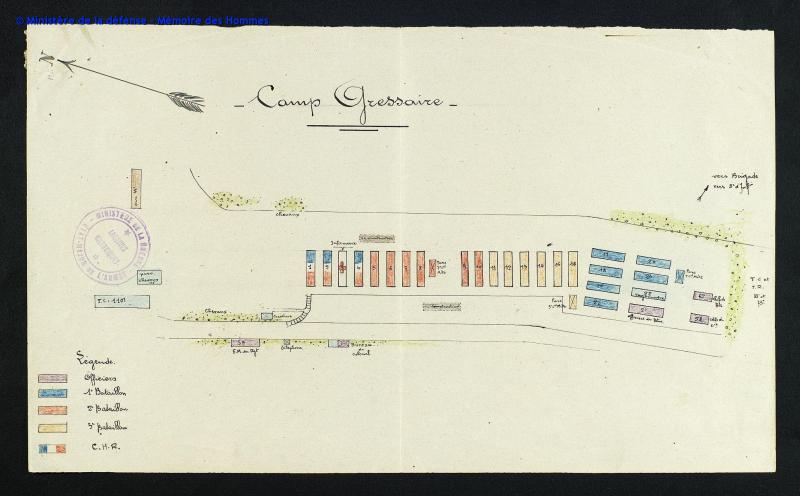
Map of Camp Gressaire (source: JMO of the 110 RI).





